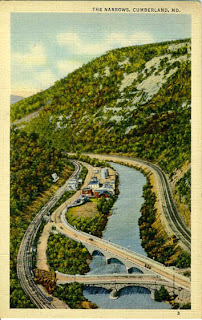
It features a painting and is called "View of Lover's Leap and The Narrows". At the bottom it says "1652 Ft. Above Sea Level, Cumberland, MD. 4"
On the back, it says, "Lover's Leap and The Narrows, Cumberland, Maryland. From Lover's Leap one may view the National Highway (U.S. 40) one thousand feet below. The city of Cumberland and surrounding states of Pennsyvania and West Virginia may be seen from this point."
My research tells me that this postcard is likely showing a 1937 view, but may have been produced in 1951 as it is printed on linen stock by Marken & Bielfeld. In fact, I found a matching postcard (it is numbered 3 on the bottom) for sale for $8 to $10. It is by the same company, looks similar to this but is the 1937 Aerial View of the Narrows West of Cumberland (image on the bottom).
The legend of "Lover's Leap" exists all over the world, and certainly any place where there is a high peak. It is the thought of star-crossed lovers leaping to their deaths - sometimes alone or together. Like a Romeo and Juliet tale.
This particular point has its own legend, as explained by Phil Hoebing, Qunicy University: "For example, in Cumberland, Maryland the Lovers' Leap involved a daughter of an Indian chief and a white mother, and Jack Chadwick, a white hunter. The chief, for financial reasons, really wanted his daughter to marry, instead of the hunter, a white officer from the nearby fort instead of the hunter. After Jack became lucky and discovered silver on his property, he thought that his problems were behind him because he had now become wealthy. Jack confidently went to the chief, and again asked for his daughter's hand in marriage. The chief not only refused, but attacked Jack with a club, and, in the struggle, the chief was killed by a stone thrown by the young suitor. The girl, being distraught over the death of her father whom she loved very dearly, now knew that she could never be happy in marriage to a man who had killed her father. The legend concluded that Jack and the princess leaped, hand in hand, to their deaths. This Lovers' Leap produced another legend which has two Indians fleeing from the warring tribes who are pursuing the young lovers. As both tribes begin to get close to them, the young lady and her beloved leap to their deaths from the precipice. "
When I looked up Lovers' Leaps I was surprised (shocked actually) to find out that there is one listed in Canada not far from my hometown...It's in Elora Ontario, the site of the lovely Elora Gorge. Unbeknownest to me - although I have stomped around Elora quite a bit - is that there is a place called the "historic Hole In The Wall (an opening in the limestone walls, where stairs lead down to the Grand River) to Lover's Leap, where an aboriginal princess is said to have jumped to her death when she found out that her beloved had been killed in battle."
When I looked up Lovers' Leaps I was surprised (shocked actually) to find out that there is one listed in Canada not far from my hometown...It's in Elora Ontario, the site of the lovely Elora Gorge. Unbeknownest to me - although I have stomped around Elora quite a bit - is that there is a place called the "historic Hole In The Wall (an opening in the limestone walls, where stairs lead down to the Grand River) to Lover's Leap, where an aboriginal princess is said to have jumped to her death when she found out that her beloved had been killed in battle."

Comments
Post a Comment